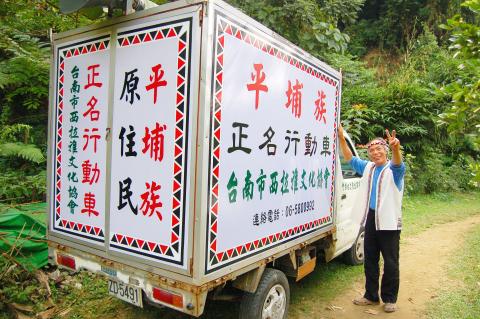|
Pingpu in
round-the-nation protest
NATIONWIDE CAMPAIGN: Wan Cheng-hsiung said that
he plans to hand out fliers to people in every municipality, city and county in
Taiwan proper by the end of the year
By Lee Yu-hsin and Jake Chung / Staff reporter, with Staff writer

Wan Cheng-hsiung, head of Greater
Tainan’s Siraya Cultural Association, gives the thumbs up next to his truck on
Nov. 16 in Greater Tainan.
Photo: Liu Wan-chun, Taipei Times
A protest demanding that the government
recognize the Pingpu and acknowledge them as an official Aboriginal tribe
started on Nov. 13 when Wan Cheng-hsiung (萬正雄), head of Greater Tainan’s Siraya
Cultural Association, began driving his truck district to district handing out
fliers.
Wan said that he plans to hand out fliers in every municipality, city and county
in Taiwan proper by the end of the year, adding that he wanted to “make the
declaration of the Pingpu as official Aborigines as hot an issue as I can.”
Wan and other members of Greater Tainan’s Siraya tribe had gathered for a
protest in font of the Presidential Office on May 2, 2009, asking the government
to declare the Pingpu the 15th official Aboriginal tribe in Taiwan.
Two-and-a-half years later, the group has yet to receive a response from the
government on their demands, even though Wan also organized a sit-in protest in
front of the Council of Indigenous Peoples in May.
To show his resolve to obtain official government endorsement for the tribe, Wan
started out on his nationwide flier campaign, placing a special emphasis on
visiting the nation’s other Aboriginal tribes.
Driving at 20kph, Wan began his trip in Greater Tainan’s Sinhua District (新化),
and he has so far visited Yujing (玉井), Tanei (大內), Dongshan (東山), Baihe (白河) and
Yongkang (永康) districts and the Greater Tainan metropolitan area.
Wan said his efforts to have the Pingpu recognized as an Aboriginal tribe are so
that the Siraya and the Ketagalan tribes would be able to register themselves as
Aborigines.
“The government has refused our pleas, citing reasons such as the Pingpu tribes
did not register as Aborigines within the given timeframe” or that they have
been “too assimilated by the Han,” Wan said, adding that the council only
started looking into the settlements, population and locations of Pingpu tribes
this year.
“If the government does not act on this issue by May 2 next year, we Pingpu will
return to Ketagelan Boulevard to protest,” Wan said.
In related developments, Siraya residents of Sinhua District’s Koupi (口埤)
settlement have recently built a stilt house, a watchtower-like structure, in
front of the local church and hope to use it to bring the tribe together for a
church music festival planned for Dec. 2.
The stilt house is a traditional Siraya structure whose construction called for
all of the settlement’s residents to work together, basing the design on the
elders’ memories of bygone days.
The residents of the settlement were earlier always willing to help each other,
as about 80 percent of the residents were Christians, villager Mu Li-chun (穆麗君)
said.
About 16 people turned out to help with the construction, Mu said, adding that
though it was meant to resemble a traditional building, the materials used were
different.
The stilts on which the house rests were built with steel to prevent them from
being damaged by rust or eaten by worms, but everything from the floor upwards
was built with traditional bamboo, Mu said, adding that originally the building
would have been open-air and it would not have had walls.
Wan said the village would be hosting the music festival annually and that the
building would also be used as a meeting place by the church and village
officials.
|
![]()
![]()
![]()